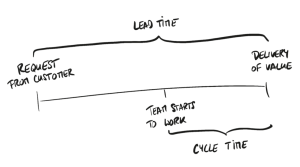Lead Time vs. Cycle Time

Both Lead Time and Cycle Time are important metrics in Agile and Lean environments, they help teams understand how efficiently work flows through their system and how long customers wait for results. While the terms are sometimes used interchangeably, they refer to different parts of the process.
-
Lead Time starts when a customer or stakeholder requests something and ends when the result is delivered. It reflects the total wait time from idea to delivery, including time in queues or waiting for prioritization.
-
Cycle Time starts when the team actively begins working on an item and ends when it's completed. It reflects the time spent in actual development or production.
Why the difference matters:
Cycle Time helps teams understand how efficiently they're working. Lead Time, on the other hand, shows how long customers are waiting. Improving Cycle Time can reduce Lead Time, but so can improving prioritization, reducing wait times, or removing blockers in the system.
Tracking both metrics gives teams better visibility into their delivery process and helps identify where to improve flow, reduce delays, and increase customer satisfaction.
